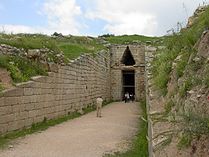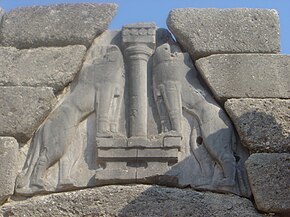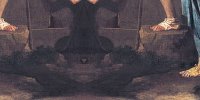Seems it was quite a portly streamlet, once upon a time...long ago.
View attachment 45108
Wikipedia:
And then this:
Thank you for this. Your additional comments are most helpful. Where you said:
"
It's basically just a question how far back in time all these myths started. Britain just got the island status 'recently' after all.", is most pertinent.
We know that Britain was an icebound wasteland during the last great ice age, so I don't think the C's can be referring back to the time of Atlantis. My own view is that we should initially focus on the period of the siege of Troy that bought Paris/Abraham, Helen/Nefertiti/Sarah and Kore/Hagar into the picture, which is about 3600 years ago or so and coincides with the last visit of the cometary cycle. This event devestated Europe, changed the climate, reduced populations and brought about widespread movements of people all over the place including the Celts of whom the Trojans may have been a sub-division.
The Bible speaks of Abraham moving to Egypt with Sarah from Ur in what is today modern Turkey or possibly from the Ur in what is today Iraq (either Assyria or Babylonia depending on timing) due to widespread famine. The C's confirmed that Nefertiti (a subterannean hybrid) was a Hittite a people who in their day were a Bronze Age supepower to rival Egypt.
Hittites - Wikipedia
The Hittites were based in Anatolia, modern day Turkey. Indeed, Turkey (Asia Minor) has been an ancient crossroads for so many tribes throughout history. As regards Abraham and the later kingdom of Judah, the Book of Genesis shows that the Hittites were friends and allies to Abraham and scholars have noted that Judah and the Hittites were never enemies in the Hebrew texts. This makes sense if Nefertiti was a Hittite princess.
The C's have said Kore was the last of the Perseid family who were the descendants in legend of Perseus and Andromeda. If so, this makes her a Mycenaean princess. In the second millennium BC, Mycenae was one of the major centres of Greek civilization, a military stronghold which dominated much of southern Greece, Crete, the Cyclades and parts of southwest Anatolia (Turkey).
Mycenae - Wikipedia
The period of Greek history from about 1600 BC to about 1100 BC is called Mycenaean in reference to Mycenae.
Mycenae (
/maɪˈsiːniː/ my-SEE-nee;
[2] Ancient Greek: Μυκῆναι or Μυκήνη,
Mykē̂nai or
Mykḗnē) is an archeological site near Mykines in
Argolis, north-eastern Peloponnese, Greece. Argolis would seem to be where the Argonauts came from.
Argolis - Wikipedia.
Argolis or
Argolida (
Greek: Αργολίδα
Argolída,
[arɣoˈliða]; Ἀργολίς
Argolís,
[argolís] in
ancient Greek and
Katharevousa) is one of the
regional units of Greece. It is part of the
region of
Peloponnese, situated in the eastern part of the
Peloponnese peninsula and part of the
tripoint area of Argolis,
Arcadia and
Corinthia. Much of the territory of this region is situated in the
Argolid Peninsula.
Mycenae developed into a major power during LHI (c. 1550–c. 1450 BC) and is believed to have become the main centre of Aegean civilisation through the fifteenth century to the extent that the two hundred years from c. 1400 BC to c. 1200 BC (encompassing LHIIIA and LHIIIB) are known as the Mycenaean Age. The Minoan hegemony was ended c. 1450 and there is
evidence that Knossos was occupied by Mycenaeans until it too was
destroyed c. 1370 BC. From then on, Mycenaean expansion throughout the Aegean was unhindered until the
massive disruption of society in the first half of the twelfth century (LHIIIC) which ended Mycenaean civilisation and culminated in the destruction of Mycenae itself c. 1150 BC.
I would particularly draw attention to this extract from the Wikipedia entry for Mycenae:
Late Helladic III (LHIII; c. 1400–c. 1050 BC)
At a conventional date of 1350 BC, the
fortifications on the acropolis, and other surrounding hills, were rebuilt in a style known as
Cyclopean because the blocks of stone used were so massive that they were thought in later ages to be the work of the one-eyed giants known as the
Cyclopes. Within these walls, much of which can still be seen, successive monumental palaces were built. The final palace, remains of which are currently visible on the acropolis of Mycenae, dates to the start of LHIIIA:2. Earlier palaces must have existed, but they had been cleared away or built over. [
A cyclops does, of course, feature in the story of Oddysseus and we know from the C's that giants were involved with the building of Baalbek,]
The construction of palaces at that time with a similar architecture was general throughout southern Greece. They all featured a
megaron, or throne room, with a raised central hearth under an opening in the roof, which was supported by four columns in a square around the hearth. A throne was placed against the center of a wall to the side of the hearth, allowing an unobstructed view of the ruler from the entrance.
Frescos adorned the plaster walls and floor.


Examples of
tholos, outside the citadel of Mycenae:
tomb of Clytemnestra, outside view (left),
Treasury of Atreus, inside view (right) .

The Lion Gate (detail); two
lionesses or lions flank the central column, whose significance is much debated.
[19]
The room was accessed from a courtyard with a columned portico. A grand staircase led from a terrace below to the courtyard on the acropolis.
In the temple built within the citadel, a scarab of
Queen Tiye of Egypt, who was married to
Amenhotep III, was placed in the Room of the Idols alongside at least one statue of either LHIIIA:2 or B:1 type. Amenhotep III's relations with
m-w-k-i-n-u, *Mukana, have corroboration from the inscription at Kom al-Hetan - but Amenhotep's reign is thought to align with late LHIIIA:1. It is likely that Amenhotep's herald presented the scarab to an earlier generation, which then found the resources to rebuild the citadel as Cyclopean and then, to move the scarab here.
Wace's second group of tholoi are dated between LHIIA and LHIIIB: Kato Phournos, Panagia Tholos, and the Lion Tomb. The final group, Group III: the
Treasury of Atreus, the Tomb of Clytemnestra and the Tomb of the Genii, are dated to LHIIIB by a sherd under the threshold of the Treasury of Atreus, the largest of the nine tombs. Like the Treasury of
Minyas at
Orchomenus [see my last post for references to that name] the tomb had been looted of its contents and its nature as funerary monument had been forgotten. The structure bore the traditional name of "Treasury".
Amenhotep III "
Amun is Satisfied"; Hellenized as Amenophis III), also known as
Amenhotep the Magnificent, was the ninth pharaoh of the
Eighteenth Dynasty. According to different authors, he ruled Egypt from June 1386 to 1349 BC, or from June 1388 BC to December 1351 BC/1350 BC, after his father Thutmose IV died.
His reign was a period of unprecedented prosperity and splendour, when Egypt reached the peak of its artistic and international power. When he died in the 38th or 39th year of his reign, his son initially ruled as
Amenhotep IV, but then changed his own royal name to
Akhenaten. Akhenaten was, of course, the heretic pharaoh who embraced monotheism and imposed it on Egypt.
Now we find the link between Akhenaten and Kore, who may have been a Mycenaean princess and who seems to have become either a prisoner or possibly a refugee at the Pharaoh's court and is given to Nefertiti/Sarah as a servant or companion under the name of Hagar in the Bible. Hagar is then given to Abraham, supposedly because Nefertiti cannot give him a male child, as either a second wife or as a concubine. Abraham has a child with her who is known in the Bible as Ishmael. However, after Sarah eventually gave birth to
Isaac, she grew angry at Hagar due to Ishmael's behaviour towards her son and persuaded Abraham to put Hagar and her son aside. According to the Bible Hagar and Ishmael end up in the land of Bersheeba.
Hagar - Wikipedia.
Islaamic tradition puts a slightly different spin on it:
According to the
Qisas Al-Anbiya, a collection of tales about the prophets, Hājar was the daughter of the King of Maghreb, a descendant of Islamic prophet Salih. Her father was killed by Pharaoh Dhu l-‘arsh (
Arabic: ذُوالْعَرْش
dhu ’l-‘arsh, meaning "he/ master of the throne") and she was captured and taken as a slave. Later,
because of her royal blood, she was made mistress of the female slaves and given access to all of Pharaoh's wealth. Upon conversion to Ibrāhīm's faith, the Pharaoh gave Hājar to Sara who gave her to Ibrāhīm. In this account, the name "Hājar" (called
Hajar in
Arabic) comes from
Hā ajru-ka (
Arabic: هَا أَجْرُكَ), the Arabic for "here is your recompense".
According to another tradition, Hājar was the daughter of the Egyptian king, who gave her to Ibrāhīm as a wife, thinking Sara was his sister.
Rabbinical tradition puts even another spin on the story:
Rabbinical commentators asserted that
Hagar was Pharaoh's daughter. The
midrash Genesis Rabbah states it was when Sarah was in Pharaoh's harem that he gave her his daughter Hagar as servant, saying: "It is better that my daughter should be a servant in the house of such a woman than mistress in another house". Sarah treated Hagar well, and induced women who came to visit her to visit Hagar also. However Hagar, when pregnant by Abraham, began to act superciliously toward Sarah, provoking the latter to treat her harshly, to impose heavy work upon her, and even to strike her (ib. 16:9).
Some Jewish commentators identify Hagar with
Keturah (Aramaic: קְטוּרָה
Qəṭurɔh), the woman Abraham married after the death of Sarah, stating that Abraham sought her out after Sarah's death. It is suggested that
Keturah was Hagar's personal name, and that "Hagar" was a descriptive label meaning "stranger". This interpretation is discussed in the Midras.
However, say instead of going to the land of Beersheba, Kore/Hagar was taken by ship (or possibly even flying saucer?) with her son and retinue to the British Isles, where Abraham had originally come from? Where could they have arrived? One possibility is the Humber
Information on the Bronze Age boats found at North Ferriby , which the River Trent flows into
Another possibility is Ireland ttps://www.ancient-origins.net/opinion-guest-authors/thoth-s-storm-new-evidence-ancient-egyptians-ireland-005
The Article mentions that one of the most intriguing examples of these proposals for an Irish connection to ancient Egypt was the discovery of the skeleton of a 15-year-old boy at The Mound of the Hostages, near
Tara, by Dr. Sean O Riordan of Trinity College. Carbon dating showed that the remains were roughly 3,800 years old. A necklace found with the skeleton was made of faience beads and matched similar Egyptian manufacture and design. My understanding is that a similar necklace was found in the tomb of Tutenkhamun, the son of Akhenaten.
So could Princess Tara be Kore/Hagar?
On the basis that the Greek classical tales were stories transposed from their original settings to ancient Greece (rather like transposing Robin Hood to America), could Jason and the Argonauts' voyage have been to Colchis in Britain rather than to Colchis in Georgia? If so, where was the Golden Fleece located? Perhaps we need to scrutinise the myths more closely for clues.
This also begs the question how much the Rosicrucians like John Dee, Francis Bacon, Poussin etc. knew about ancient history. Were they abkle to decode the myths? Had they managed to find ancient texts or did they learn through Dee's channelling the same way we have learned through Laura's channelling? And what were they up to on Oak Island? Why did they dig up the TDARM only to rebury it?
BTW: I had not appreciated the link between
George Talbot, the 6th Earl of Shrewsbury, and the River Trent until you referred to Henry Hotspur's speech in Henry VI, Part I (possibly written by Francis Bacon). That was a great spot. This ultimately confirms the link with Alton Towers. Well done.
I think the C's statement - "A:
Arcadia is a crossroads for the one Essene, the Aryan one of Trent" may in fact hold the key to all this.







